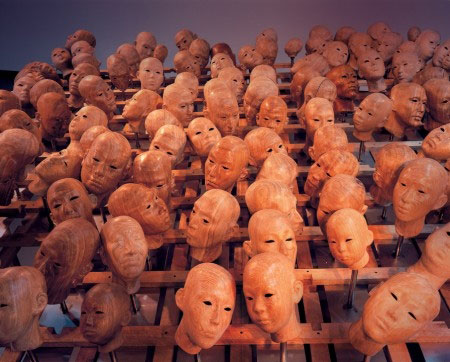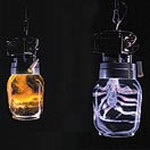
YOUNG SUN LIM at Stux Gallery
By Jessica Myers-Schecter
Midnight—Oya, Korean artist Young Sun Lim’s multi-media installation exhibit currently at Stux Gallery in Chelsea,
explores how life in the modern urban world has become increasingly stripped of its individuality via oppressive political
regimes, scientific advances and futile industrial repetition. In doing so he underlines the essential frailty and immutable
particularity, of human existence.
In Body Of The Host II, a sister installation to Lim’s 1999 Body of the Host, 200 jars are suspended from the ceiling by wires.
Inside each blue or green-lit bottle floats a silicon form: some resemble human organs, others diaphanous jellyfish, and still
others fetuses in various stages of development. Music plays eerily in the background, apparently in “reaction” to the movement
of visitors through the gallery space. But as you weave your way through the maze of suspended jars, carefully sideswiping
wires and gazing at the illuminated silicon creatures, it’s almost impossible to tell where the music is coming from let alone
that your own movements are tripping the sensors. Standing there at the center of the clot of jars you feel as if you’ve stumbled
onto a den of clandestine organ “pharmers” or an odd cloning experiment worthy of yet another Matrix.
The central piece, located in a narrow hallway adjacent to the main gallery, Dong Chan—Pale Blue Moo consists of tiers of
170 smooth carved wooden human heads which rotate slowly at random intervals, echoing dully as they knock into each other again
and again. Hollow eye sockets stare out from expressionless faces. In the first tier, centered as though in a position of honor,
a child’s head revolves ceaselessly, hitting a bronze bell each time it passes through the center point. Though each of the
170 heads is a portrait of a particular person, stripped of hair and adornment as they are, the group appears frightening in its
uniformity. The effect is one of senseless movement and of enforced homogeny.
Lim’s work is of course heavily influenced by his own experiences with the devastation war and revolution can bring—devastation
both physical and spiritual. He was a student in Seoul during the turbulent ‘80s and was a member of the revolutionary Min Joong
(or People’s Art) movement. The Kwangju Massacre, in which hundreds were killed by the military regime, resonates in particular
in Lim’s work. But personal tragedy suffuses the work as well: Lim’s own studio, and all the work in it, burned to the ground in 1998.
 In this particular exhibit, themes of dislocation, detachment, loss and redemption permeate the installations. Both pieces
divorce the human from its individuality in startling ways. In Body of the Host II birth is divorced from a human mother, from
the human body itself and enclosed in individual glass cells. In Dong Chan each distinct face is stripped of identifying marks and
the eyes, usually the most emotive feature, are blacked out. In several, the nape of the neck or the back of the head is stenciled
with silver Korean lettering, as if branded or tattooed.
In this particular exhibit, themes of dislocation, detachment, loss and redemption permeate the installations. Both pieces
divorce the human from its individuality in startling ways. In Body of the Host II birth is divorced from a human mother, from
the human body itself and enclosed in individual glass cells. In Dong Chan each distinct face is stripped of identifying marks and
the eyes, usually the most emotive feature, are blacked out. In several, the nape of the neck or the back of the head is stenciled
with silver Korean lettering, as if branded or tattooed.
Taken together, the pieces evoke an uneasy relationship with religion: the tiers of wooden portraits stare blankly forward, as
if worshiping the anonymous child banging against the bronze bell. Even the title Body of The Host II calls to mind the Christian
sacrament while simultaneously evoking the relationship between parasite and host or even, more poignantly, between fetus and
mother. But instead of providing comfort or sustenance, religion becomes merely another facet of alienation, a hollow parody. A
mere reference.
Young Sun Lim’s Midnight – Oya will be on view at the Stux Gallery (450 West 25th St. stuxgallery.com) through November 26.
|

















